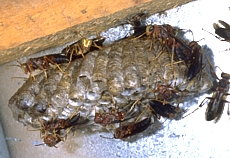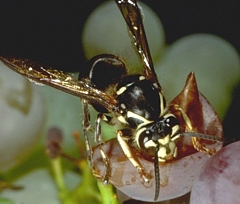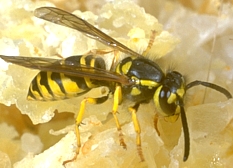|
|
ARTHROPODS:
Insects»
Spiders»
Centipedes»
Millipedes»
Sowbugs»
Harvestmen»
Mites
& Ticks»
Scorpions»
Identification
Tips»
About
the Critter Files»
Links» |
|
|
|
| |
| TAXONOMY |
KINGDOM:
Animalia | PHYLUM: Arthropoda | CLASS: Insecta | ORDER : Hymenoptera
FAMILY: Vespidae | SUBFAMILIES: Polistinae (paper wasps), Vespinae
(hornets and yellowjackets) |
| |
WHAT
ARE HIVE WASPS?
LIFE CYCLE
ECOLOGY
PEST STATUS
COMMON KENTUCKY HIVE WASPS
COLLECTING & PHOTOGRAPHY
HIVE WASP FACTS
MYTHS, LEGENDS, AND FOLKLORE |
| |
| WHAT
ARE HIVE WASPS? |
|
| Paper
Wasps, Hornets, and Yellowjackets
are a group of closely related wasps in the family Vespidae. Like
all wasps, these have four transparent or translucent wings and chewing
mouthparts. All of the wasps mentioned on this page live in social colonies in above-
or below-ground hives. It can be difficult to distinguish hive wasps
from some of the larger solitary wasps. The best way is to observe
behavior: hive wasps will remain close to their hive and return to
it often during their daily routine. Also, many hive wasps have
distinct patterns of red-and-black, white-and-black, or yellow-and-black (although some solitary wasps have similar color patterns). |
| |
|
| SIZE:
Adult body length up to 1 1/8" |
| |
| LIFE
CYCLE |
|
Like
all wasps, paper wasps, hornets, and yellowjackets have complete
metamorphosis with egg, larva, pupa, and adult stages. Because
these wasps live in social colonies, all of the immature life stages
are kept inside the hive and are rarely seen. Hive wasp larvae
are soft and maggot-like and live inside small cells within the
hive, where they also pupate. Eggs are laid by the dominant
queens. The majority of the members of a hive are female.
Only a few males appear each year, and their role is to fertilize
queens. Queens lay eggs during warm months. When the
eggs hatch, the helpless larvae are fed by workers. During
winter months, all of the colony dies except for a few egg-baring
females who hide in protected areas until the following spring.
Each hive or nest consists of very closely related siblings.
Wasps from different hives do not work together. |
| |
 Hornet Nest (R.
Bessin, 2002)
Hornet Nest (R.
Bessin, 2002) |
| |
| ECOLOGY |
|
Paper wasps, hornets,
and yellowjackets are social insects that live and work together in
hives. Workers patrol the local environment for food and bring
it back to the hive to feed larvae and other hive members. Hive
wasps are omnivores, and gather a wide variety of food, but insects
and other arthropods are a primary food. Hornet, yellowjacket,
and wasp hives often have dozens or hundreds of members. Members
of a single hive can catch and eat thousands of insects, including
pest species. In addition to gathering food, workers also labor
to build hives. Hives are complex structures made of a paper-like
substance that the wasps make from partially chewed wood. Worker
wasps are equipped with stingers, and they use these weapons to defend
their hives from predators (wasp larvae are a very good food source
for many predators, including mammals, birds, and insects). Hive
wasps are very tough, but they are sometimes killed and eaten by birds,
spiders, and other insects.
|
| |
 A paper wasp
gathering wood for the nest (B. Newton, 2005)
A paper wasp
gathering wood for the nest (B. Newton, 2005) |
| |
| PEST
STATUS |
|
Although
paper wasps, hornets, and yellowjackets eat lots of pest insects
and are often beneficial to humans, hives that exist close to
human environments can cause problems. In fact, wasps,
hornets, and yellowjackets can be a serious medical concern, especially
for people who are allergic to their stings. Read more about
the concerns of hive wasps at our online factsheet:
http://www.uky.edu/Ag/Entomology/entfacts/struct/ef620.htm |
| |
| COMMON
KENTUCKY HIVE WASPS |
|
|
PAPER
WASPS
SUBFAMILY: Polistinae
| GENUS: Polistes, others
Paper Wasps
are among the most common insects encountered around homes. Paper
wasp nests are usually built on tree limbs and under the eaves of
homes. Unlike the nests of hornets and yellowjackets, paper
wasp nests are not completely enclosed. Paper wasp nests are
also usually smaller than the nests of hornets and yellowjackets.
Their are several paper wasp species in Kentucky, and most
are about 1" long with vivid red, black, orange, and yellow
patterns. |
| |
 Paper Wasp (R.
Bessin, 2000)
Paper Wasp (R.
Bessin, 2000) |
 Paper Wasp Nest (R. Bessin, 2000)
Paper Wasp Nest (R. Bessin, 2000) |
|
|
|
HORNETS
SUBFAMILY: Vespinae
The most common Hornet
in Kentucky is probably the Bald-Faced Hornet (3/8" long),
Dolichovespula maculata (recently changed from Vespula maculata), pictured below. These distinctive
black-and-white wasps build large nests in the limbs of trees and
other such locations. Kentucky is also home to the Giant
Hornet, also called the European Hornet, Vespa crabo. The giant hornet is our largest hornet, reaching
lengths of 1 1/8." It is very similar in appearance to
the smaller yellowjacket. The European
Hornet is not a native insect, but was introduced to the United States
in the 1800s. Giant hornets often build their nests in enclosed
spaces, such as hollow trees, animal burrows, and wall voids in buildings.
Hornets are typically not as common around homes as paper wasps and yellowjackets,
preferring to make their nests in forests, meadows, and rural areas. |
| |
 Bald-faced Hornet
(R. Bessin, 2000)
Bald-faced Hornet
(R. Bessin, 2000) |
|
|
|
YELLOWJACKETS
SUBFAMILY: Vespinae
| GENUS: Vespula & Dolichovespula
Yellowjackets
are close relatives of hornets and are in the same subfamily, Vespinae.
These wasps have a bold black-and-yellow pattern and are usually
1/2-3/4" long. They build their nests underground in animal
burrows or in hollow logs or wall voids. Yellowjackets are common
around humans, and sometimes cause problems at picnics and other outdoor
activities. |
| |
 Yellowjacket
(R. Bessin, 2000)
Yellowjacket
(R. Bessin, 2000) |
|
| |
| COLLECTING
& PHOTOGRAPHY |
|
Hive wasps are common
and easy to find around homes and other buildings where they visit
flowers for nectar and patrol plants for insect prey. Because
of their stings, great care must be taken when adding a hive-dwelling wasp to
a collection or trying to get a picture. If you are allergic
to wasp, ant, or bee stings, you should never try to catch a hive
wasp: ask your doctor to test whether or not you are allergic. Hive
wasps should never be touched, and should be caught only in a net
and transferred immediately to a sturdy glass container. It
is usually safe to get a picture of a hunting worker wasp or hornet as
long as the insect is not touched or disturbed. |
| |
| HIVE
WASP FACTS |
|
The stings of worker
wasps, hornets, and yellowjackets are modified egg-laying structures
called "ovipositors." Because workers do not lay
eggs, their ovipositors are used only for stinging.
Although all of the wasps
mentioned on this page are in the family Vespidae, not all wasps
in this family live in hives. Some are solitary and live alone
in small burrows. |
| |
| MYTHS
- LEGENDS - FOLKLORE |
|
| It is sometimes said that
hive wasps will not sting at night. This is not true! Although
hive wasps are typically less active at night, they WILL sting to defend
their hives. |
|
Original document: 25 May 2004
Last updated: 21 Apr 2008
Photos courtesy R.
Bessin and B. Newton, University of Kentucky
The Kentucky Critter Files are maintained by Blake Newton, Department
of Entomology, University of Kentucky.
Contact: blaken@uky.edu |
|

